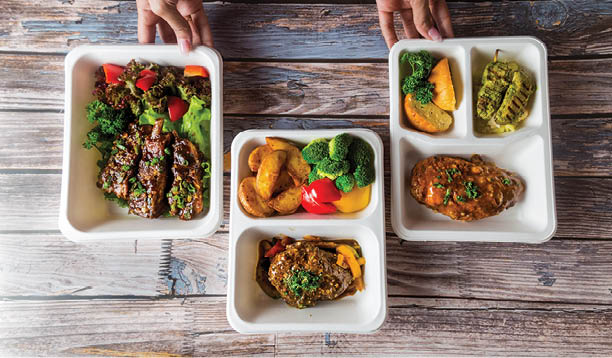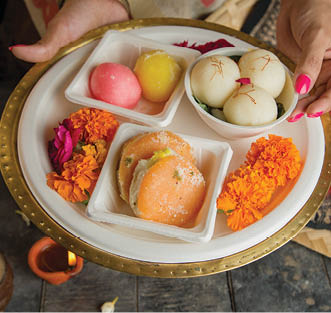Ecoware’s 100% natural and biodegradable products cater not only to large businesses but also to individual consumers and home-based entrepreneurs across India, including those in smaller towns and cities. In an exclusive interview with Paper Mart, Ms. Rhea Mazumdar Singhal, Founder & CEO of Ecoware Solutions Private Limited, shares her insights on the need for a comprehensive ban on single-use plastics, the growing momentum in sustainable food packaging innovation, and the importance of promoting healthy packaging solutions that can create a long-lasting impact and shift consumer behavior toward eco-conscious choices.

Paper Mart: The plastic reduction movement has gained momentum through both regulatory action and consumer demand. From your perspective, which force has more directly impacted the momentum around reducing plastic waste? What specific event or market shift prompted your company’s strategic response?
Rhea Mazumdar Singhal: We’ve been in the market for 15 years and were among the first companies in India to introduce bagasse pulp-molded tableware in 2010. We’ve stayed committed to one focus which is to eliminate single-use plastic by providing sustainable, plant-based alternatives to plastic.
When the Indian government announced a plastic ban in 2022, it seemed like a step in the right direction. However, the ban excluded takeaway containers used by food delivery platforms like Zomato and Swiggy which is one of the largest sources of plastic waste in the country. This loophole has left a major part of the problem unaddressed, and enforcement has not been quite forceful.
However, we remain optimistic as Indian consumers are intelligent and increasingly conscious of the environment. Their choices reflect their environmental concern and more people are making thoughtful, sustainable choices in their everyday lives. Today, if someone is spending INR 150 for a cup of tea, they expect more than just the beverage—they expect quality in the entire experience, including the packaging.
PM: How do you balance environmental claims against practical concerns like supply chain reliability and product performance metrics?
RMS: In India, our raw material sourcing is entirely local as two main crops we rely on—sugarcane and wheat—are indigenous to the region. Over the years, we’ve developed a thorough understanding of their seasonality, geographic distribution, pricing trends, and the factors that influence the cost of the pulp derived from them, making our supply chains mature and predictable.
When it comes to product development, we focus on a few key performance metrics. Each client comes with a unique requirement, and we make sure that we meet their needs. Whether it’s a specific thickness, weight, or functionality—like oil resistance, waterproofing, microwave compatibility, or durability under sub-zero conditions—we deliver customized solutions that are tailored to the end-use. For example, if an ice cream brand needs packaging that holds up for five days in sub zero temperature, we know exactly how to engineer that. Our deep understanding of the raw materials and the production process allows us to adapt quickly and effectively, ensuring that every product we manufacture meets the performance metric for the customers.
Watch: In Pursuit of Lesser Water Footprint
PM: Market adoption of biodegradable tableware appears driven by multiple stakeholders. Between corporate sustainability initiatives or B2B clients, consumer preferences, and regulatory frameworks, which segment has most meaningfully influenced the adoption in general and your sales growth. How has this mix evolved in the last few years?
RMS: We’re seeing growing demand not just from large businesses, but also from individual households and consumers in smaller towns and cities across India. Through our e-commerce platform, we receive hundreds of orders every day from customers who find it convenient to buy products online. Our customers include people who need sustainable packaging for family gatherings, a birthday party, a religious celebration, or simply to pack food while traveling. We’re also proud to serve home-based entrepreneurs—like a housewife who sells their food within her neighborhood, or has a small café or tiffin service in a local community. What unites all these customers is a shared value: they care about what they’re serving, and how it’s presented.
PM: Innovation in materials science continues to reshape production capabilities. What specific technological advancement—whether in raw material processing, manufacturing techniques, or product design—has most significantly enhanced your competitive position in this sector?
RMS: From the very beginning, we’ve invested time and effort into understanding and optimizing every aspect of the manufacturing process. Whether it was developing the right raw material formulation, fine-tuning the thermoforming process, identifying optimal operating temperatures, minimizing rejection rates, optimizing energy usage, automating key processes, or reducing dependence on manual labor—each of these components has been refined through a rigorous, and iterative process.
We remain deeply committed to innovation. We’re constantly exploring new materials and packaging technologies. For example, there’s a growing demand for sustainable packaging that also offers extended shelf life. Addressing this need requires a holistic approach to the entire packaging ecosystem. This could involve incorporating biodegradable, compostable barrier materials that preserve food while naturally disintegrating. We might also need to develop new locking systems to maintain food integrity during transit and devise efficient stacking solutions that allow us to deliver voluminous packaging products in an efficient manner in the client’s warehouse facility without taking much space. We are constantly pursuing these kinds of forward-looking innovations.
Further, regional variations in cuisine—from South to East India—demand localized packaging innovations. That level of cultural and culinary variety opens up entirely new avenues for innovation, making India not just a market of scale, but a market of ideas. For us, food packaging is not limited to sustainable alternatives; it’s about reimagining the entire packaging experience, end to end.

PM: The terms “biodegradable” and “compostable” carry distinct certification requirements yet are used interchangeably in the marketplace. How does your company address this distinction when developing products, and what impact has this had on your certification strategy and manufacturing processes?
RMS: The terms ‘biodegradable’ and ‘compostable’ are often used interchangeably. However, we avoid using the ‘compostable’ term even though our products are certified compostable under US, European, and Indian standards, which ultimately align under ISO 17088.
In India, most people use the term compostable but there is no public access to composting facilities. No one should claim ‘compostability’ without the proper certification. I believe that the industry will follow suit and stop using these terms interchangeably.
PM: Even well-designed biodegradable products require appropriate waste management infrastructure. What specific infrastructure gaps most frequently undermine proper product disposal, and how is your company addressing these post-consumer challenges?
RMS: Waste management or disposal is not a challenge for our products because they are made entirely from plant-based materials—specifically, agricultural waste. The products are 100% plant-based consisting of agricultural residue of crops. If they end up with kitchen or organic waste in a landfill, they will naturally disintegrate. If they mistakenly go into a recycling stream alongside plastics, paper, or aluminum, they pose no contamination risk and can be broken down or processed. When you consider the overall lifecycle cost of our products, Ecoware products are cheaper compared to plastics or other alternatives. They’re sustainable, biodegradable, and cost-effective without any waste disposal issues.

We have the potential to go deeper into tier-2 and tier-3 cities and towns. Currently, our domestic demand accounts for approximately 80% of our sales, while exports contribute the remaining 20%.
PM: What targeted regulatory change or incentive structure would most effectively accelerate your company’s growth trajectory, and what specific barriers have prevented its implementation?
RMS: We need to approach this from two clear perspectives. First, the 2022 plastic ban must evolve into a truly comprehensive ban that includes all single-use plastic items. At present, only 19 items are covered—leaving out major contributors to plastic pollution which is plastic food containers and takeaway packaging, used extensively in the restaurant sector and home deliveries. Second, from a regulatory standpoint, the government must adopt a far more aggressive stance against plastic. One effective measure would be to significantly increase taxation on plastic. This alone would act as a strong disincentive for both manufacturers and consumers, pushing them to adopt sustainable alternatives.
The conversation around banning plastic isn’t new. Many have already moved toward paper-based or alternative sustainable materials. One major concern for banning plastic was that it might hurt employment. But the industry has had time to adapt, and workers can be retrained or absorbed into greener segments of the economy.

PM: Is your company positioning to compete internationally or are domestic scale and quality standardization issues still the primary focus of your operational strategy?
RMS: We currently export to around 15 countries, and one of our key strengths lies in the abundant availability of raw materials in India. This gives us a strong foundation to continue expanding our export footprint.
Recent shifts in global trade dynamics have also moved in our favor. The U.S. has imposed higher tariffs on imports from countries like China and Indonesia as compared to India. India is becoming an increasingly attractive alternative for businesses that are looking to diversify and de-risk their supply chains.
While export opportunities are growing, we believe India too is a massive market and we’ve barely penetrated into this domestic market. The potential to go deeper into tier-2 and tier-3 cities and towns is immense.Currently, domestic demand accounts for approximately 80% of our sales, while exports contribute the remaining 20%.
Also Read: Dinearth Discovers Strategic Growth Avenues in International Markets
PM: The five-year outlook for biodegradable tableware remains subject to debate. Does your company view these products as eventual complete replacements for conventional plastics, or as one component in a more diverse portfolio of sustainability solutions?
RMS: There’s a strong momentum and a global shift towards biodegradable tableware. In global forums, recent discussions were centered around implementing a global ban on single-use plastics. The fact that such conversations are taking place at the highest levels indicates a clear and growing consensus towards sustainable solutions and I’m optimistic that in the next five to six years, we will see a widespread ban on most forms of single-use plastic.
At the same time, I believe we’re on the cusp of significant innovation in sustainable packaging. This isn’t just about replacing plastic but building an entire ecosystem. Pulp-molded tableware will be one part of that system, but we’ll also see advancements in barrier coatings and bioplastics derived entirely from bio-based sources, which will mimic the properties of plastic, while being able to disintegrate within a defined period.
The future will bring a wide array of solutions. Take PET bottles, for example — many brands want to retain product visibility for consumers and if we can innovate materials that offer transparency while being environmentally safe, it would represent a breakthrough. Our products will play a complementary role in this evolving ecosystem. The momentum is real, and I’m hopeful this industry will grow in multiple exciting directions.
PM: What are your thoughts on creating a standardized labeling system for packaging?
RMS: One of the topics I’m deeply passionate about is the standardization of sustainable packaging. We need a visual identity system for packaging — something that clearly distinguishes sustainable packaging from harmful materials. This kind of intuitive labeling could nudge consumers toward making better, more conscious choices — not just about their products, but also about how it’s packaged. I think that’s a very powerful way of changing consumer behavior. Because at the end of the day, no regulation, taxation, or government oversight can create a long-lasting impact unless consumer demand itself shifts.



